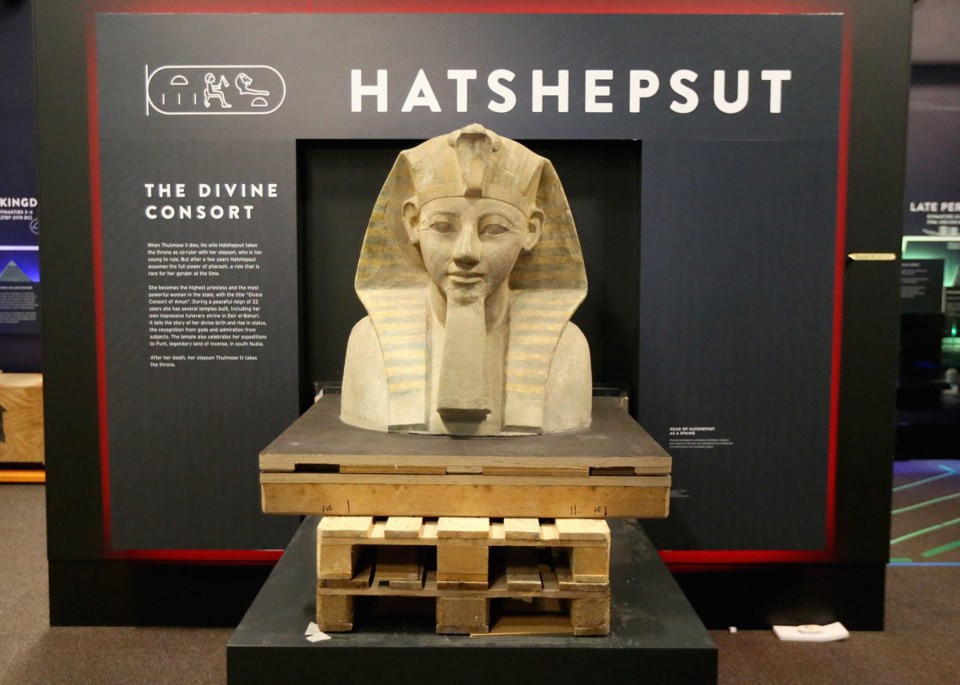Among all the wonders to be unveiled when Egypt: Time of Pharaohs debuts at the Royal B.C. Museum next week, here’s what you won’t see: Mummies.
Or, to be precise, mummified humans. Cats, yes, humans, no.
That’s the difference between the museum’s thinking today and its approach in 2004, when the Eternal Egypt exhibit featured a mummy brought in to pull more punters through the turnstiles.
“It was there for the purpose of spiking visitor numbers,” says Jack Lohman, a note of disapproval in his voice. Not that he’s against visitors — far from it — but the idea of attracting them through the gratuitous display of dead people leaves him cold.
“As long as I’m running this institution, we will follow ethical guidelines where we don’t collect or display human remains,” the museum CEO says.
The use of mummies, skeletons and other human bits has become a bone (as it were) of contention in the international museum world. Some do. Some don’t. In New York, the American Museum of Natural History just wrapped up (as it were) an exhibit featuring 18 mummies from Egypt and Peru. The 5,500-year-old remains of a stabbed-to-death Egyptian known as Gebelein Man (even better known as Ginger because of his red hair) have been gawked at in the British Museum for more than a century. Vienna’s Weltmuseum caused a fuss by showing a severed head that a Brazilian tribe had once taken as a war prize (the Brazilian tribe was fine with the display, but nobody asked the severed head). The Museum of Vancouver no longer displays its Egyptian mummy Penechates but will let students into a locked room to view it for educational purposes.
This subject is a passion for Lohman, who has not only written about it extensively, but acted: Upon becoming director of the Museum of London, he removed from display the remains of a boy who had died of rickets. It’s not as if it were a medical museum with a teaching compenent.
While some might apply the same time-and-distance rules that render tasteless humour palatable, Lohman rejects the notion that it’s OK to display somebody else’s ancestors for entertainment (and have no doubt, many museums find themselves torn between the desire to be a serious, scholarly institution and the need to be a money-making tourist attraction). It doesn’t matter whose ancestors they are or where they’re from.
“I have always argued that you need one set of ethical guidelines for museums,” Lohman says. “Humans are humans.”
Fortunately, he says, people in B.C. are accepting of that notion. “Everybody gets it.”
That wasn’t always the case, here or elsewhere, though in one of those pendulum swings that mark society’s changing sensibilities, the same museums that once competed to collect human remains have spent a generation trying to return them. Indigenous communities across North America have reburied thousands of their ancestors in the last couple of decades.
This goes back to the 19th century, when some of America’s most august institutions — the American Museum of Natural History, the Smithsonian, Harvard’s Peabody Museum — got into bone collecting in a big way. The practice became much more widespread as the 20th century dawned and the field of physical anthropology grew. Universities and museums scooped up the dead from around the world, studying them for skeletal variation. They thought they were doing the right thing.
The practice wasn’t as common in Canada, not because we were appalled by what was going on but because it was only the big human-history museums that had the necessary resources. The Royal B.C. Museum never did do much physical anthropology, though it opened its collection to visiting scholars. Nor was it haunted by the ghoulish spectre of grave-robbing; most of the remains it housed came from archeological excavations, or were brought in by police after someone stumbled across them in the bush.
For the past 60 years or so, the museum’s practice has been to turn over remains (that can mean as little as a single bone, or as much as an almost-intact skeleton) when asked by Indigenous groups. In 1997, the institution went a step further and began contacting bands directly. Many responded, claiming the remains of several hundred ancestors. In one big repatriation in 2001, the remains of 400 people were returned to Nanaimo’s Snuneymuxw First Nation. (That was seven years before the American Museum of Natural History returned ancestral remains to the Tseycum First Nation.)
Still, another 700 ancestral remains have yet to be claimed from the Victoria museum. Some are of uncertain lineage, while others are linked to communities that aren’t certain what to do with them. The museum recently hired a repatriation specialist to help with a process that Lohman says is as much about the transfer of authority over remains, of control over any research involving them, as it is about their physical return.
Meanwhile, ancient remains that emerge during excavation still get referred to the museum by the coroner’s office or police, but the museum won’t take them without the consent of the relevant First Nation.
As for Egypt: Time of Pharaohs, there should be plenty among its 350 artifacts to dazzle you, mummies or not.



